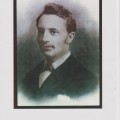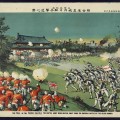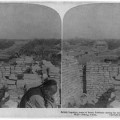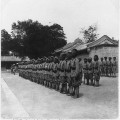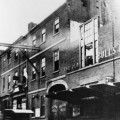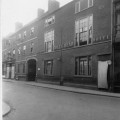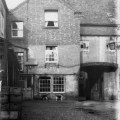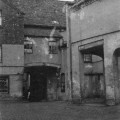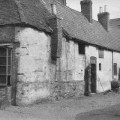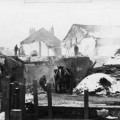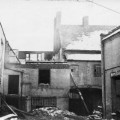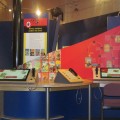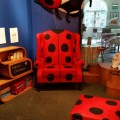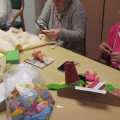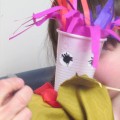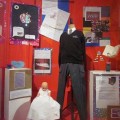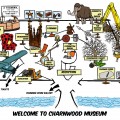Alfred Woodroffe, Christian Missionary and victim of the Boxer War
19 May 2015
- Alfred Woodroffe
- The Fall of Pekin Castle. Image sourced from the Library of Congress Prints and Photographs Division Washington, D.C.
- ‘Scene from the barricaded city wall – Peking China’. Image sourced from the Library of Congress Prints and Photographs Division, Washington, D.C.
- Chinese refugees assembling at the boat landing on the Pei-ho, Tientsin, China. Image sourced from the Library of Congress Prints and Photographs Division, Washington, D.C.
- Sikh troops on guard in grounds of summer palace near Peking, China. Image sourced from the Library of Congress Prints and Photographs Division, Washington, D.C.
Alfred Woodroffe (1872 to 1900)
No part of Alfred Woodroffe’s life was easy but he had a simple, robust faith which called him to respond to the challenge of taking the Christian Gospel to China to what was then seen as the very end of the earth. He overcame many obstacles and eventually it was circumstances completely beyond his control that led to his tragic, untimely death.
Alfred Woodroffe’s mother lived in Costock but shortly after her marriage to a groom in a local stable and the birth of Alfred (her first child) they moved to Loughborough where Alfred grew up. For his basic education he attended the Churchgate Church of England School and on leaving there worked as a butcher’s assistant.
On Sundays he went to the Parish Church but became convinced that the Christian gospel should be actively proclaimed, an aim which he pursued for the rest of his life. He came to Baxtergate Baptist Church with its then fiery Rev. Edward Stevenson as senior minister and settled into its evangelical worship and outreach. He was baptised at the age of 18 along with other young people on 6th July 1890.
A year later he moved to Cardiff and worshipped in Tredegarville Baptist Church, where he became a Sunday school teacher and outreach worker which included leading services in the local Barnado’s home. While in Cardiff he applied to Dr. Guiness’s College (later Cliff College) for training for the mission field and on his second application was accepted.
During his three months’ vacation from College, he returned home to Loughborough and led services in our Church and helped with outreach in Baptist churches in the town and surrounding villages. His valedictory service was held on Wednesday August 25th 1897. A few weeks later he sailed with ten other young men on the long voyage to China.
In China
The China Island Mission began in 1865 under the leadership of Rev. James Hudson Taylor and William Berger at a time when the vast country was becoming more open to foreigners and allowing Christian missionaries to enter. Hudson Taylor responded energetically to this opportunity, travelling widely in Britain urging young men and women to respond to this challenge for Christian witness and the adventure of helping to open up the land and people for the Christian gospel. He also travelled through America and Australia seeking recruits so that in all, some 800 missionaries were recruited in his lifetime. In his busy life he managed to make twelve visits to China to assess progress and encourage the missionaries.
For the missionaries there was no salary offered, which obliged them to live ‘by faith’ and become closely involved with their local communities, living, working and dressing like them. For Alfred Woodroffe, coming from a hardy labourer’s family in Loughborough, this part would have been no problem and he would have seen it as just part of reaching out to the Chinese people with the Christian gospel.
The Boxer War
The opening up of the Chinese empire to western influence happened from the middle of the 19th century.
China was unprepared for the modern age but neighbouring Japan had developed western industry and had weapons which enabled it to defeat the Chinese armies in 1894. The outcome to this was the humiliating loss of Korea and the ceding of the island of Taiwan to the Japanese.
At the same time in the towns and villages there was feeling against Christian missionaries because of their threat to local ancient beliefs and the withdrawal of converts from festivals and local taxes. It is against this background that the Boxer War took place. In all fifty-eight missionaries died, including twenty-one children. These actions were viewed with horror by the local people.
After several months at a CIM training and linguistic college where it was said that ‘he smiled his way through the difficulties of life,’ Alfred was posted with a young Australian to the province of Shansi which borders on Mongolia. In this rugged countryside he became noted for his tireless touring of the villages which often lasted several weeks. It was the area of the country most affected by the Boxer uprising and so in 1900 when Woodroffe was 28 years old, the two missionaries fled into the mountains, where they suffered and died.
His death received only modest notice in Loughborough because premature death on the mission field was all too frequent at the time. As a former member of our church, we can be proud of his Christian life of witness and service to the Chinese people.
Stan Cramer, Loughborough Baptist Church
Sources: Our Union Magazine: the Organ of the Loughborough district and West Leicestershire Baptist Union, November 1900.
Other texts consulted: Forsythe, R.C. The Chinese Martyrs of 1900 and The Chinese Millions, Vol. 8, New Series, 1900. Pub. China Inland Mission.
These texts are held in the Archives of the China Island Mission at the School of Oriental and African Studies of the University of London. You can read ‘The Chinese Martyrs of 1900‘ online, with the article about Alfred Woodroffe on page 86 (page 54 in the original text).
Read an article about Protestant Missionaries and the Boxer War from Loughborough University historian, Dr Thoralf Klein.
Read a story from Loughborough resident Eva Weng on how her family’s life in China was changed forever after meeting British missionaries.
Claudia Parsons remembers Loughborough Landladies in 1919
15 May 2015
‘This is a story of the twentieth century’, of the ‘young women’ who had ‘begun to emerge from the sheltered life to go to universities or to take any jobs that were allowed to them in a man’s world.’
So begins the memoirs of Claudia Parsons, a woman who as a teenager in 1919, set out with ‘little more than the proverbial shoestring’ to seek a job that would give her a knowledge of the world as well as an income. Her search was to bring her to Loughborough’s Technical College, an institution which had trained and employed female munitions workers during WWI and, in a period hostile to women remaining in industry, was still prepared to accept women on their engineering diploma courses.
Writing about opportunities for women which are now taken for granted, Parsons describes her first year of learning general engineering followed by two years studying the relatively new subject of automobile engineering. Alongside the male students, Claudia and her female peers were involved in hands-on learning in the College’s workshops, foundry and drawing-office.
Claudia was one of only four women at the College at this time and there were mixed reactions to their presence in the town.
‘If the [male] students paid respect, not so the landladies,’ she writes. ‘Loughborough was then a small parochial-minded town, and we were looked on with the utmost suspicion, thought to be abandoned even before we came.’ Though hostels were available for the men, lodgings had to be found in the town for the ‘lady engineers’. These were secured with a local schoolmistress, though the arrangement wasn’t to last.
‘The schoolmistress soon found us too much, and fixed us up with a nice old body who fed and housed us generously. But a postcard sent to Patience by her mother: ‘Darling I can’t bear to think of you pigging it in filthy lodgings in Loughborough’, was not unnaturally our undoing. We were out on our ears before the end of the week, and suffered thereafter a painful series of short anchorages, until Patience took refuge with a friend she had made at the golf club, and I answered an advertisement and went to see a clergyman’s widow who had rooms to let at reasonable price.’
‘Her greeting: ‘I’ve heard all about you people’ was not promising. The interview improved, however; she would take Dorothea and me on approval for a month, and in fact we stayed with Mrs Abbott for the rest of the time we were at college, and she proved a very kind friend. There was a piano in our sitting-room to which I told my secret heart, unaware that when I played, Mrs Abbott would sit on the stairs in the hall to listen. Had I known I could not have played a note, but this was not revealed till departure.’[1]
Unconventional and ahead of her time, Claudia would go on to spend almost twenty years as a courier and chauffeur-companion in an era when roads were poor or non-existent and cars dangerously unreliable. Criss-crossing the continents during her many commissions, she is reputed to be the first woman to circumnavigate the world by car.
You can read more about Claudia Parsons from the Women’s Engineering Society as well as about her friend and fellow Loughborough graduate Verena Holmes.
Read more about Women in Engineering at Loughborough here.
Click here to see an image of Claudia Parsons by Boo Beaumont (1996) in the National Portrait Gallery and here to see another by Margaret Palmer (1992) which is currently held at Loughborough University.
Monday 18th May 2015 sees Loughborough University host the 2015 Claudia Parson’s lecture, an event to encourage more women to consider a career in science, technology, engineering and maths (STEM). This year the lecture is to be delivered by engineer, TV and radio presenter Kate Bellingham.
Alison Mott
[1] From Claudia Parsons, Century Story, Lewes 1995
Election Hustings in Old Loughborough
6 May 2015
Originating from the words hasting (Old English) or húsþing (Old Norse) meaning ‘house thing’ – a gathering of the household of a king, earl or chief – the word hustings now signifies the campaigning carried out by candidates in the lead-up to an election, in which they address potential voters and try to win their votes.
In the past, campaigning often centred around local ale houses, where the combination of alcohol, strong opinions and political dissent created a heady mix which often turned into trouble.
The Old Bull’s Head Hotel in the High Street (later rebuilt as the Black Bull and currently a gym) was Loughborough’s main coaching inn and a focal point of the town. It was frequently ‘a rough house’ at election meetings, where nominating and voting for candidates took place in the open air, for all to see.
Another hostelry which featured in electoral hustings was the Plough Inn in the Market Place, where the town’s Justices of the Peace held Petty Sessions in a room upstairs. Brick steps led up to the courtroom, whilst stone steps led to the inn. The need not to mistake the two was a local standing joke.
On one occasion, Mr E B Farnham was speaking from the Plough when a hayfork was pushed towards his face, a potato on one prong and a herring on the other, with the invitation to ‘chaw on this!’ Farnham had recently stated that a herring and a potato were good enough food for a working man.
In 1852 the Marquis of Granby addressed local electors from the courtroom of the Plough. He was supported by a crowd of farm workers brought from the other side of Leicestershire for the purpose. These were managed by a tall, stout farmer named Marriott, who prompted them to cheer whenever the Marquis made a point.
The Riot Act had to be read from the Town Hall steps during the election in 1857, when the ‘free and independent electors’ of the town, supported by a mob who weren’t entitled to vote, smashed the windows of the Bull’s Head to vent disapproval at Lord John Manners and Mr. Farnham being elected as Members of Parliament. A similar disturbance occurred at the Bull’s Head in the election of 1859.
During another election, the town centre was gridlocked from the Bull’s Head through to the entrance of the Town Hall. Lord John Manners stood in his carriage at the corner of Biggin Street and threw silver coins into the crowd.
In 1868 the crowd were once again out of sorts with Lord John Manners, who had recently voted for the retention of flogging as a form of punishment in the army. Waving cat-o-nine tails at him, the mob heckled Lord John and a second candidate – a Mr Clowes – but gave their support to a Mr Frewen, whom they seem to have viewed as the underdog. Frewen was elected by a large majority, but so was Lord John, despite having received very few votes. He was escorted away by police under a barrage of rotten eggs, rabbit skins and rubbish, to save him being torn to pieces.
This proved to be the last open nomination in the town – and possibly in England – as it was decided to be safer for candidates to be nominated inside the municipal buildings.
Alison Mott
Source: W. A. Deakin, 19th Century Loughborough, The Echo Press Limited, 1974.
- The Bulls Head, Loughborough, prior to High Street being widened in the late 1920s. Photo courtesy of leicestershirevillages.com
- The Bulls Head, Loughborough, prior to High Street being widened in the late 1920s. Photo courtesy of leicestershirevillages.com
- The rear yard of The Bulls Head, Loughborough, prior to High Street being widened in the late 1920s. Photo courtesy of leicestershirevillages.com
- The rear yard of The Bulls Head, Loughborough, prior to High Street being widened in the late 1920s. Photo courtesy of leicestershirevillages.com
- The Bulls Head, Loughborough, prior to High Street being widened in the late 1920s. Photo courtesy of leicestershirevillages.com
- The Bulls Head, being demolished to make way for the widening of the High Street being widened in the late 1920s. Photo courtesy of leicestershirevillages.com
- The Bulls Head, being demolished to make way for the widening of the High Street being widened in the late 1920s. Photo courtesy of leicestershirevillages.com
Ladybird, Ladybird
5 May 2015
Local project commemorates Loughborough’s links with Ladybird Books
- The new gallery at Charnwood Museum has interactive displays and recordings of people’s memories of the company.
- One of the ladybirds from the Beeches Road factory sits above the new talking story chair.
- Participants making toys and games for the 8 story sacks produced as part of the project.
- The gallery display created by students from the Roundhill Academy, Thurmaston.
- The new museum map created by local illustrator Andy Everitt-Stewart.
Ladybird Ladybird was an Arts Council England funded project hosted by Charnwood Museum in partnership with Leicestershire County Council. The aim of the project was to develop pilot projects to celebrate the centenary of Ladybird Books in 2015 and to lay the foundations for the first Loughborough Festival of Children’s Illustrated Literature.
Ladybird Ladybird set out to engage with families, children and new and existing audiences through events, activities and the redisplay of the Ladybird gallery at the museum. Partnership work was integral to the success of the project and resulted in a range of activities working with organisations such as Charnwood Children’s Centres, Roundhill Academy, Charnwood Arts and Twenty Twenty. The Ladybird Gallery in the museum was refreshed with the addition of new touchscreens, new text panels and a new area dedicated to sharing stories.
Are you sitting comfortably….?
The very first Ladybird Book, Tiny Tots Travels, was published in Loughborough in 1914. The company remained in the town until 1999 when, following an earlier takeover by Penguin, book production moved elsewhere. Ladybird Books covered a huge range of subjects from maths to nature to classic fairy tales. One of the most well-known series of books was the Key Words Reading Scheme or ‘Peter and Jane’ books. For many years Ladybird books have helped children to learn to read and the idea of sharing stories and reading books was an important part of the Ladybird Ladybird Project.
Taking reading and sharing stories as inspiration, a project working with Charnwood Children’s Centres, the Charnwood Family Network and Leicestershire County Council Adult Learning was established. The project was designed to create a series of story sacks based on popular Ladybird book titles. The participating parents were asked to choose a Ladybird book and to then create a story sack based on it. Most of the parents had never sewn before so this presented them with a new challenge. With the support of the course tutor the parents produced 8 story sacks, 4 for Charnwood Museum and 4 to be circulated around the Children’s Centres. To complement the story sack course a day of storytelling was held at the museum in January 2015 with Katrice Horsley, the former National Storytelling Laureate. This in turn led to 2 days of storytelling training held by Katrice for library and museum staff and parent volunteers from the Family Network.
The story of Ladybird Books in Loughborough is wide reaching and many people have relatives or know someone who once worked at the factory. Reflecting the personal side of the Ladybird Book story was as important as the story of the development of the company. As part of the gallery redevelopment 2 volunteers undertook the task of gathering a series of oral history testimonies about Ladybird. The speakers ranged from ex staff to collectors and enthusiasts. In total 13 testimonies were collected and they can all be heard in the new gallery display at Charnwood Museum. In addition to this Charnwood Arts have worked with Twenty Twenty, a charity which works with disadvantaged and disengaged young people in Leicestershire, to develop a History Pin tour of Ladybird in Loughborough. Using photography, film making and stop-frame animation, the young people involved in the project have developed a range of material based on Ladybird books.
The redevelopment of the Ladybird Gallery was one of the most important elements of the project and a fitting tribute to the centenary of this iconic brand. The gallery tells the story of Ladybird in Loughborough. Visitors can learn about the history and heritage of the company through text panels, touchscreen interactives and photographs. A sharing stories space has been created with a bespoke bookcase and wooden bench and the talking ‘ladybird’ chair. The shelves are filled with books and toys to help families and children share stories and the joy of reading Ladybird Books. The museum team were even able to mount one of the ladybirds from the front of the Beeches Road factory on to the museum wall!
Alongside these projects the museum hosted lots of activities for children and families. These ranged from the grand ‘Son et Lumiere’ display in Queen’s Park in October 2014, to puppet making and Manga drawing workshops during school holidays. Ladybird Ladybird also supported a ‘Takeover Day’ for Roundhill Academy. As part of the national Kids in Museum initiative, a class from the school were invited into the museum to curate a display case, undertake a mystery shopper exercise and to develop trails and museum quizzes.
A new museum gallery map has also been created by local illustrator Andy Everitt-Stewart, who worked for Ladybird in the 1990s.
Charnwood Museum is open to the public every day except Monday.
Follow Charnwood Museum on Facebook and Twitter @Charnwood Museum
